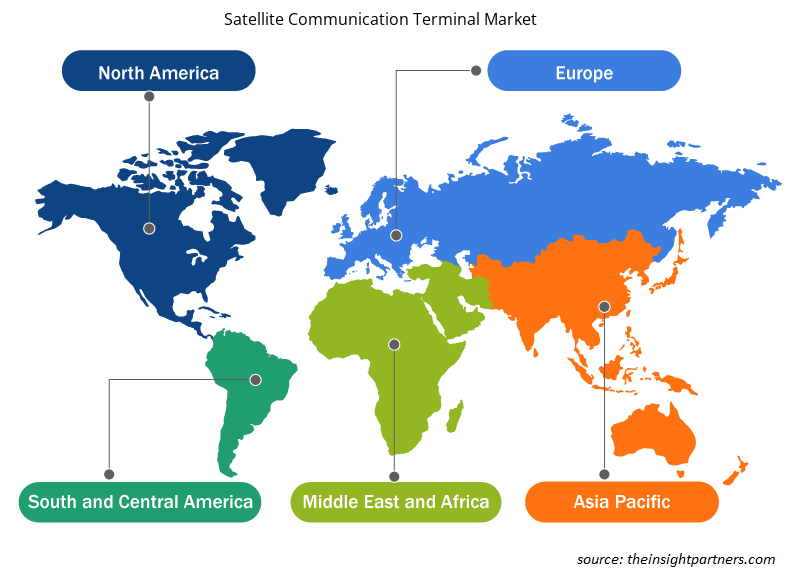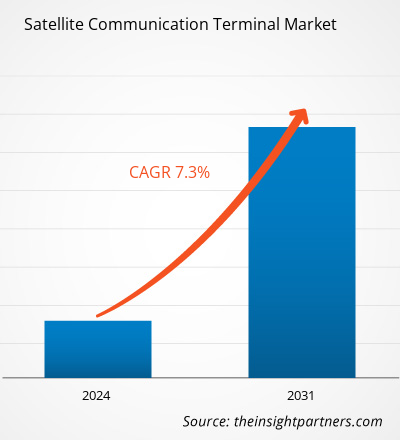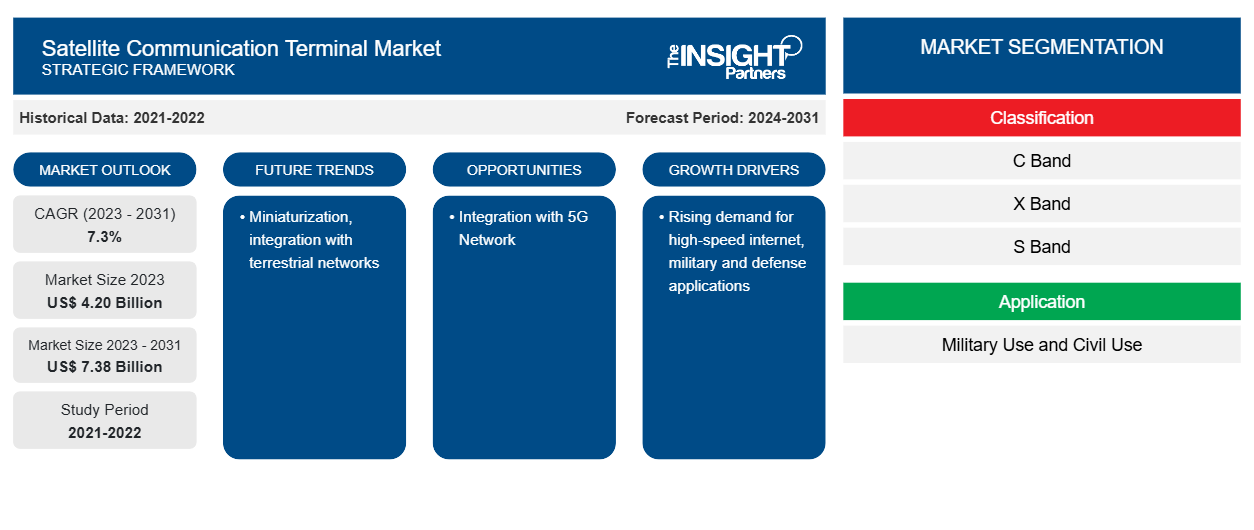Es wird erwartet, dass der Markt für Satellitenkommunikationsterminals von 4,20 Milliarden US-Dollar im Jahr 2023 auf 7,38 Milliarden US-Dollar im Jahr 2031 anwächst.Es wird erwartet, dass der Markt zwischen 2023 und 2031 eine durchschnittliche jährliche Wachstumsrate von 7,3 % verzeichnet. Miniaturisierung und Integration mit terrestrischen Netzwerken dürften weiterhin ein wichtiger Trend auf dem Markt bleiben.CAGR of 7.3% during 2023–2031. Miniaturization and integration with terrestrial networks are likely to remain a key trend in the market.
Marktanalyse für Satellitenkommunikationsterminals
Ein SATCOM-Terminal, kurz für Satellite Communications Terminal, ist ein Gerät, das Kommunikationsverbindungen über Satelliten herstellt. Es umfasst eine Antenne für Signalübertragung und -empfang, ein Modem für Datenmodulation und -demodulation und in einigen Fällen Signalverstärker. Das Terminal kommuniziert mit Satelliten, die die Erde umkreisen und Nachrichten an Bodenstationen oder andere Terminals senden. Diese Technik ermöglicht Fernkommunikation an abgelegenen oder unzugänglichen Orten.
Marktübersicht für Satellitenkommunikationsterminals
Satellitenkommunikationsterminals haben eine Vielzahl von Einsatzmöglichkeiten. Sie werden im Militär eingesetzt, um eine sichere und zuverlässige Kommunikation zu gewährleisten, in der Luftfahrt für die Flugverkehrskontrolle und Flugzeugkommunikation, in der Seefahrt für die Schiffsverfolgung und Sicherheitskommunikation, im Katastrophenfall zur Einrichtung von Notfallkommunikation, im Rundfunk zur Übertragung von Fernseh- und Radiosignalen und in abgelegenen Gebieten, in denen es keine terrestrischen Netzwerke gibt.
Passen Sie diesen Bericht Ihren Anforderungen an
Sie erhalten kostenlos individuelle Anpassungen an jedem Bericht, einschließlich Teilen dieses Berichts oder einer Analyse auf Länderebene, eines Excel-Datenpakets sowie tolle Angebote und Rabatte für Start-ups und Universitäten.
- Holen Sie sich die wichtigsten Markttrends aus diesem Bericht.Dieses KOSTENLOSE Beispiel umfasst eine Datenanalyse von Markttrends bis hin zu Schätzungen und Prognosen.
Treiber und Chancen auf dem Markt für Satellitenkommunikationsterminals
Zunehmende Militär- und Verteidigungsanwendungen begünstigen den Markt
Militäreinheiten nutzen Kommunikationssatelliten, um ihre Infanterie- und Feldeinheiten zu organisieren und zu koordinieren. Sie ermöglichen taktische Kommunikation unterwegs und können einfach in Fahrzeuge, Kriegsschiffe und Flugzeuge integriert werden. SATCOM ist eine entscheidende Komponente des C4ISR-Systems (Command, Control, Communications, Computers, Intelligence, Surveillance and Reconnaissance) des Militärs. Es ermöglicht Echtzeitkommunikation zwischen verteilten Streitkräften, Navigation und Fernüberwachung , was die Effizienz militärischer Operationen verbessert. Mit der technologischen Entwicklung haben sich Qualität, Geschwindigkeit und Genauigkeit der Satellitenkommunikation erheblich verbessert, was eine bessere strategische Planung und Durchführung ermöglicht. Im November 2023 kündigte Intelsat an, dass es der US-Armee bald neue, flexible und vollständig verwaltete Unterstützung für Multi-Orbit-Satellitenkommunikation (SATCOM) bieten werde, nachdem es den ersten Vertrag der Armee für Satellitenkommunikation (SATCOM als Managed Service, SaaMS) vergeben hatte. Dies treibt das Marktwachstum voran.SATCOM is a critical component of the military's C4ISR system (Command, Control, Communications, Computers, Intelligence, Surveillance, and Reconnaissance). It permits real-time communication between dispersed forces, navigation, and U.S Army with new, flexible, and fully managed multi-orbit satellite communications (SATCOM) support, following the award of the Army’s first-ever Satellite Communication (SATCOM) as a Managed Service (SaaMS) contract. This is driving the market growth.
Integration mit dem 5G-Netzwerk
SATCOM und 5G können zu einem Netzwerk kombiniert werden, das nahtlose Konnektivität über viele Kommunikationstechnologien wie Mobilfunk, WLAN und Satellit bietet. Dieses integrierte Netzwerk eignet sich für eine Vielzahl von Anwendungen, darunter Fernerkundung, unbemannte Fahrzeuge und Augmented Reality. In einem Szenario der elektronischen Kriegsführung (EW) können SATCOM und 5G zusammenarbeiten, um sichere und dauerhafte Kommunikationsfunktionen bereitzustellen, die gegen Störungen, Abfangen und andere Formen von Interferenzen resistent sind. SATCOM kann einen Backup-Kommunikationskanal bereitstellen, falls das terrestrische Netzwerk gestört oder gestört wird, während 5G ein sicheres und robustes Kommunikationsnetzwerk für die lokale Kommunikation zwischen verschiedenen Einheiten und Plattformen bereitstellen kann. and 5G can be combined to form a network that offers seamless connectivity across many communication technologies, such as cellular, Wi-Fi, and satellite. This integrated network is suitable for a variety of applications, including remote sensing, unmanned vehicles, and augmented reality. In an Electronic Warfare (EW) scenario, SATCOM and 5G can collaborate to provide secure and durable communication capabilities resistant to jamming, interception, and other forms of interference. SATCOM can provide a backup communication channel in the event that the terrestrial network is jammed or disrupted, whereas 5G can provide a secure and robust communication network for local communication between various units and platforms.
Marktbericht über Satellitenkommunikationsterminals – Segmentierungsanalyse
Wichtige Segmente, die zur Ableitung der Marktanalyse für Satellitenkommunikationsterminals beigetragen haben, sind Klassifizierung und Anwendung.
- Basierend auf der Klassifizierung ist der Markt für Satellitenkommunikationsterminals in C-Band, X-Band, S-Band, Ku-Band und Ka-Band unterteilt.
- Basierend auf der Anwendung wird der Markt in militärische und zivile Nutzung unterteilt. Das Segment der militärischen Nutzung hatte im Jahr 2023 den größten Anteil.
Marktanteilsanalyse für Satellitenkommunikationsterminals nach Geografie
Der geografische Umfang des Marktberichts für Satellitenkommunikationsterminals ist hauptsächlich in fünf Regionen unterteilt: Nordamerika, Asien-Pazifik, Europa, Naher Osten und Afrika sowie Süd- und Mittelamerika.
Nordamerika dominierte den Marktanteil von Satellitenkommunikationsterminals im Jahr 2023. Länder in der Region wie die USA und Kanada investieren stark in den Verteidigungssektor. Im August 2021 vergab die US-Marine einen Auftrag über 16 Satellitenkommunikationsterminals an L3Harris Technologies, Inc. Dieser Auftrag soll einen Wert von 18 Millionen US-Dollar haben und soll den Zugang zu kommerzieller Breitbandkommunikation während maritimer Operationen ermöglichen. Dies treibt das Wachstum des Marktes in der Region voran.
Regionale Einblicke in den Markt für Satellitenkommunikationsterminals
Die regionalen Trends und Faktoren, die den Markt für Satellitenkommunikationsterminals während des Prognosezeitraums beeinflussen, wurden von den Analysten von Insight Partners ausführlich erläutert. In diesem Abschnitt werden auch die Marktsegmente und die Geografie von Satellitenkommunikationsterminals in Nordamerika, Europa, im asiatisch-pazifischen Raum, im Nahen Osten und Afrika sowie in Süd- und Mittelamerika erörtert.

- Erhalten Sie regionalspezifische Daten zum Markt für Satellitenkommunikationsterminals
Umfang des Marktberichts zu Satellitenkommunikationsterminals
| Berichtsattribut | Details |
|---|---|
| Marktgröße im Jahr 2023 | 4,20 Milliarden US-Dollar |
| Marktgröße bis 2031 | 7,38 Milliarden US-Dollar |
| Globale CAGR (2023 - 2031) | 7,3 % |
| Historische Daten | 2021-2022 |
| Prognosezeitraum | 2024–2031 |
| Abgedeckte Segmente | Nach Klassifizierung
|
| Abgedeckte Regionen und Länder | Nordamerika
|
| Marktführer und wichtige Unternehmensprofile |
|
Marktteilnehmerdichte: Der Einfluss auf die Geschäftsdynamik
Der Markt für Satellitenkommunikationsterminals wächst rasant, angetrieben durch die steigende Nachfrage der Endnutzer aufgrund von Faktoren wie sich entwickelnden Verbraucherpräferenzen, technologischen Fortschritten und einem größeren Bewusstsein für die Vorteile des Produkts. Mit steigender Nachfrage erweitern Unternehmen ihr Angebot, entwickeln Innovationen, um die Bedürfnisse der Verbraucher zu erfüllen, und nutzen neue Trends, was das Marktwachstum weiter ankurbelt.
Die Marktteilnehmerdichte bezieht sich auf die Verteilung der Firmen oder Unternehmen, die in einem bestimmten Markt oder einer bestimmten Branche tätig sind. Sie gibt an, wie viele Wettbewerber (Marktteilnehmer) in einem bestimmten Marktraum im Verhältnis zu seiner Größe oder seinem gesamten Marktwert präsent sind.
Die wichtigsten auf dem Markt für Satellitenkommunikationsterminals tätigen Unternehmen sind:
- Airbus
- AVL Technologien
- Collins Luft- und Raumfahrt
- General Dynamics Mission Systems, Inc.
- Honeywell International Inc.
- L3Harris Technologies, Inc.
Haftungsausschluss : Die oben aufgeführten Unternehmen sind nicht in einer bestimmten Reihenfolge aufgeführt.

- Überblick über die wichtigsten Akteure auf dem Markt für Satellitenkommunikationsterminals
Nachrichten und aktuelle Entwicklungen zum Markt für Satellitenkommunikationsterminals
Der Markt für Satellitenkommunikationsterminals wird durch die Erhebung qualitativer und quantitativer Daten nach Primär- und Sekundärforschung bewertet, die wichtige Unternehmensveröffentlichungen, Verbandsdaten und Datenbanken umfasst. Nachfolgend sind einige der Entwicklungen auf dem Markt für Satellitenkommunikationsterminals aufgeführt:
- Airbus hat mit den Verteidigungsministerien der Tschechischen Republik und der Niederlande Verträge über die Bereitstellung von Satellitenkommunikation für 15 Jahre unterzeichnet. Die Streitkräfte der Tschechischen Republik und der Niederlande werden jeweils 2 bzw. 3 Kanäle der von Airbus gehosteten UHF-Nutzlast (Ultra High Frequency) für militärische Kommunikation an Bord des Telekommunikationssatelliten EUTELSAT 36D nutzen, dessen Start für 2024 geplant ist. (Quelle: AIRBUS, Pressemitteilung, September 2022)
- AvL Technologies (AvL), Datum Systems und Wavestream haben im Juli bei einer drahtlosen digitalen Schnittstellendemonstration zusammengearbeitet. Ziel der erfolgreichen Demonstration war es, ein digitales Schnittstellenmodem/BUC-Paar, das nur durch ein CAT5-Kabel verbunden war, zu nutzen, um Benutzerdaten über Satellit zu übertragen. (Quelle: AvL Technologies, Pressemitteilung, August 2022)
Marktbericht zu Satellitenkommunikationsterminals – Abdeckung und Ergebnisse
Der Bericht „Marktgröße und Prognose für Satellitenkommunikationsterminals (2021–2031)“ bietet eine detaillierte Analyse des Marktes, die die folgenden Bereiche abdeckt:
- Marktgröße und Prognose für Satellitenkommunikationsterminals auf globaler, regionaler und Länderebene für alle wichtigen Marktsegmente, die im Rahmen des Berichts abgedeckt sind
- Markttrends für Satellitenkommunikationsterminals sowie Marktdynamiken wie Treiber, Einschränkungen und wichtige Chancen
- Detaillierte PEST/Porters Five Forces- und SWOT-Analyse
- Marktanalyse für Satellitenkommunikationsterminals mit Blick auf wichtige Markttrends, globale und regionale Rahmenbedingungen, wichtige Akteure, Vorschriften und aktuelle Marktentwicklungen
- Branchenlandschaft und Wettbewerbsanalyse, die die Marktkonzentration, Heatmap-Analyse, prominente Akteure und aktuelle Entwicklungen auf dem Markt für Satellitenkommunikationsterminals umfasst
- Detaillierte Firmenprofile
- Historische Analyse (2 Jahre), Basisjahr, Prognose (7 Jahre) mit CAGR
- PEST- und SWOT-Analyse
- Marktgröße Wert/Volumen – Global, Regional, Land
- Branchen- und Wettbewerbslandschaft
- Excel-Datensatz
Aktuelle Berichte
Erfahrungsberichte
Grund zum Kauf
- Fundierte Entscheidungsfindung
- Marktdynamik verstehen
- Wettbewerbsanalyse
- Kundeneinblicke
- Marktprognosen
- Risikominimierung
- Strategische Planung
- Investitionsbegründung
- Identifizierung neuer Märkte
- Verbesserung von Marketingstrategien
- Steigerung der Betriebseffizienz
- Anpassung an regulatorische Trends





















 Kostenlose Probe anfordern für - Markt für Satellitenkommunikationsterminals
Kostenlose Probe anfordern für - Markt für Satellitenkommunikationsterminals